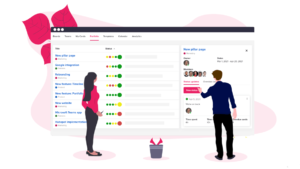Although we cannot predict for how long we will be confined to working from home, what we do know is that the trends pointing towards an increase in remote workers aren’t going anywhere, pandemics or not.
To help you effectively lead your remote team we have compiled some tips for you. Before we start, remember that your team needs to adapt to this new situation. There might be a temporary drop in productivity while everyone is getting settled in. In this phase, it’s important to trust your team and give them the freedom and flexibility to get work done on the schedule that helps them be at their most productive.
1. Keep spirits up with digital check-ins
You wouldn’t walk into the office in the morning without saying hello to your coworkers, and there is no reason to stop doing this now.
Even for those accustomed to it, working from home can feel unstructured and isolating. To mitigate this, as much as possible of the communication should be face-to-face and instant.

Whether you choose to do this by a morning meeting on video conference, regular manager check-ins or informal video meetings to grab a coffee, there are ample opportunities for engagement and bonding.
Create a digital space (i.e an always open video conference room) where the team can get together when they need a breather. Host a wine raffle or celebrate a birthday!
Suggested tools for video meetings and screensharing:
There are many easy-to-use video solutions to choose from. In the Microsoft and Google ecosystems, you have Microsoft Teams (replacing Skype for Business Online) and Google Hangouts Meet. You also have Cisco’s long-time conferencing service WebEx Meetings, and the more recent market entries Zoom and Whereby to mention a few.
2. Set guidelines for team communication
In an office, most of the communication happens synchronously (here and now). When it comes to remote working most of the conversation is done asynchronously. This results in a delay between the question and the response when communicating. Put guidelines in place to clarify how you need or want the team to use the communication channels at their disposal. Being bombarded with non-critical messages which one feels compelled to instantly respond to is not great for productivity.

The communication guidelines could address:
1. Desired frequency of communication
– How often can your remote employees expect to hear from you and vice versa?
2. Which communication channel should be used for which message?
– Chat is often used for anything that is non-urgent or informal
– Email can be for more formal subjects
– Team collaboration tools for project/task-related issues
In our efforts to be efficient, we sometimes use fewer words to communicate. Although it will save you time, this often results in your team wasting time trying to interpret your messages.
If you are finding yourself spending too much time coming up with a thoughtful response, make it normal for you and the team to jump on video to share information and to ask quick questions.
Suggested tools for instant messaging:
For instant messaging, you can choose between apps that are bundled into the services you already use or standalone apps.
If you already use Office 365 or G Suite, it might make sense to use Microsoft Teams or Google Hangouts Chat, since you already have access to it.
If you need your more integrations or features, Slack might be better for you. Slack integrates with almost 2000 different apps, not just the ones in the Google or Microsoft ecosystem.
3. Implement tools for real-time collaboration
With a remote team, it is more important than ever to communicate direction and prioritizations well. Discuss hours, goals or targets with your team members.

While email and chat are great tools, it can be quite cumbersome to coordinate a project or collaborate on a document over endless email threads and chat. This is where real-time collaboration tools shine.
A team collaboration tool will give you, and everyone on the project, the necessary overview of who does what by when.

By allowing for task-related discussions to take place in relation to the task itself, it makes for more effective communication.

With real-time editing of documents, on the other hand, two or more people can go through a single document together. Changes are saved immediately to maintain version control. There’s a comment feature for editors and project managers to make suggestions and request edits, and the track changes feature is another plus for remote collaborative teams.
Suggested tools for real-time collaboration:
For collaborating on documents and files, we recommend G Suite (with Google Docs, Sheets and Slides), Microsoft Office 365 (with Word, PowerPoint, Excel) or Dropbox Paper – depending on which tools your team already use. These apps lets you create and edit files with your team in real-time.
For collaboration on tasks and projects, Upwave is a great alternative. It’s a visual collaboration platform that lets you get full overview of what everyone is working on.
The takeaway: Define clear goals with the right tools
The ultimate goal is keeping employees and teams safe. With this new need for working from home, leaders have a golden opportunity to quickly and meaningfully enable their teams to continue working with little to no interruption of their schedules and productivity. With the pointers outlined in this article and leaders dedicated to supporting and facilitating effective collaboration in remote teams, every coworker can realize their full potential.
To help you stay on track during this challenging situation brought on by Covid-19, Upwave is offering a 3-month free trial if you get in touch with us.





